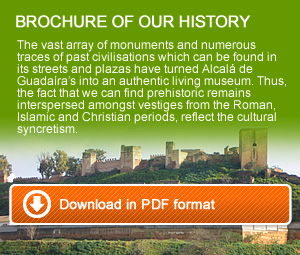

When were built the first mills in Alcalá? The buildings we see today are mostly from a later period, built from the 16th century on. However, we have references in written documents from the 12th century. During the Andalusí Period (Almohad, 12th and 13th centuries) several miller enclaves already existed along the course of the River Guadaíra. All of them were linked to familiar lineages who shared among them the use of the river course: Banu Qinana, Banu Ocba, Banu Arusa... Some of these buildings would be re-used after the Castilian conquest of the 13th century, remaining to the present time (this is the case of the Benarosa Mill or the one of Aceña Mill). However, there is no material evidence of these first mills because the ones that were re-used would be successively re-built and enlarged in later centuries.
After the Conquest mills are distributed among the Castilian new settlers; also during the Late Middle Ages (13th to 15th centuries) newly built mills would be added up, generally like feudal or ecclesiastic grantings. This would be the case of San Juan Mill, granted to the military order of the same name (with headquarters in Tocina), or the Algarrobo Mill, property of the Sevillian Monastery of San Jerónimo (St. Jerome's).
But the great development of Alcalá's Mills is carried out during the Modern Age (16th to 18th centuries). It is in this period when the Guadaíra's list of mills is completed, by means of the construction or reconstruction of most of them: Hundido Mill, Benarosa, San Juan, El Algarrobo, Realaje, Pelay Correa, Cerrajas... Also some other mills in some of the Guadaíra's tributaries would be built, completing this way the intensive use of the basin: Mills of Marchenilla, Oromana, La Tapada, El Zacatín... Other mills would be built in secondary beds, as Gandul brook, tributary to Salado.
During the Modern Age, the use of the mills of Alcalá was carried out in different ways. The property of the buildings was not only at private hands, but also at ecclesiastic institutions', which in turn sold or hired each mill, so rarely the miller was the owner of his working place.
At Alcalá's miller bank there are two essential types of mill, according the way the river is used. On one hand we have the channel or river mills, in these ones water is dammed by means of a weir (artificial barrier) or a pond (polygonal artificial enclosure). In both cases, water is concentrated as through a funnel, flowing into the buckets, spaces placed under the mill in which the hydraulic machinery is located. On the other hand we have the reservoir mills, which channel the water (generally not from the main course, but form a brook or a tributary) through an aqueduct, irrigation ditch or reservoir (tajea) to the buckets that in this case show a fall of several metres high to the spaces in which the machinery is housed.
In both the river and the reservoir mills, the grinding or milling technology is based on the rodeznos (hydraulic wheels), mechanisms in which water moves a set of horizontal shovels that in turn they a vertical rode that has in its top the millstones. There are no mills of vertical wheel in the Guadaíra (aceñas), although the name of some mill (like Aceña Mill) could take to confusion.
Most of the mills of Alcalá's bank were kept on in working order until the 20th century. Nevertheless, technological advances, along with the problems that the baker industry faced during the Civil Post-War, would make their survival unviable. Between 1950 and 1970 these facilities would go being abandoned, some of them already in a tumbledown preservation status.
From 1998, the Alcalá's Town Council starts an ambitious program of recovery of the miller bank, inside the Guadaíra Urban Bed Recovery Plan. The urban bank mills (Las Aceñas, Benarosa, San Juan, El Algarrobo, San Francisco, La Tapada and Realaje) have undergone several recovery actions, from a heritage perspective where the memory of their importance for the local economy goes along with the cultural heritage value of these historic buildings.

